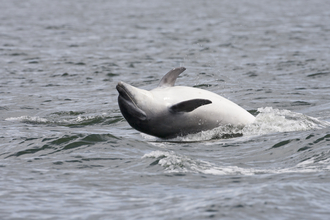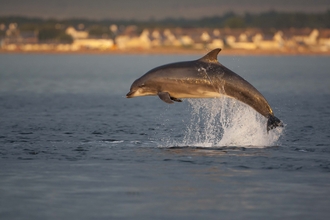
Common Dolphins ©Chris Gomersall/2020VISION
Common dolphin
These energetic dolphins are often spotted in large groups which will approach boats, bowriding and leaping alongside. At sea, they can form superpods - huge groups made up of thousands of individuals!
Scientific name
Delphinus delphisWhen to see
January to DecemberSpecies information
Category
Statistics
Length: up to 2.7m Weight: up to 150kg Average Lifespan: up to 35 yearsConservation status
Protected in the UK under the Wildlife and Countryside Act, 1981, listed under CITES Appendix II and classified as a Priority Species under the UK Post-2010 Biodiversity Framework. Also protected under the Conservation (Natural Habitats, etc.) Regulations (Northern Ireland) 1997
Habitats
About
Common dolphins (also referred to as short-beaked common dolphins) are an offshore species but often come close to shore to feed. They are highly social and normally found in groups, travelling at speed and frequently leaping from the water. They feed mainly on fish and will work together to herd their prey into a ball.How to identify
A slender dolphin, they are dark grey above and whiter below. Common dolphins have a distinctive hourglass pattern on their sides, including an obvious yellow-cream area starting behind the long, narrow beak. The dorsal fin is tall and triangular and curves slightly backwards.Distribution
Found all around the UK, most common off South and West coasts and offshore.Did you know?
Common dolphins are fast! They can reach swimming speeds of around 30 miles per hour when chasing food or bowriding alongside boats.How people can help
Report your Common dolphin sightings to your local Wildlife Trust. If you meet Common dolphins whilst at sea, maintain a distance of at least 100m, especially if calves are present. If the dolphins approach you, maintain a constant speed and allow them to interact on their own terms and leave at will. If you find a stranded Common dolphin (dead or alive), please report it to the relevant authority. The Wildlife Trusts are working with Government to find solutions to fishing bycatch across all marine species. You can support our work by joining your local Wildlife Trust and by choosing sustainably sourced seafood.




